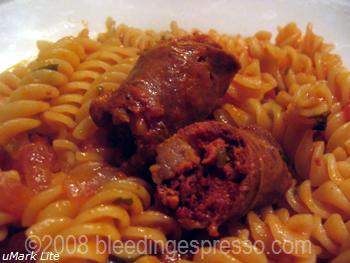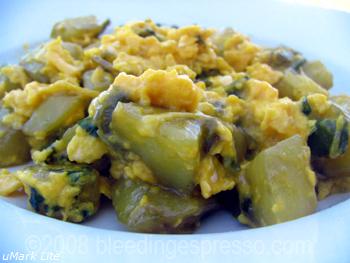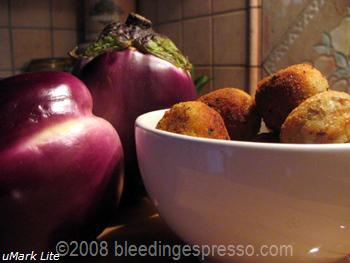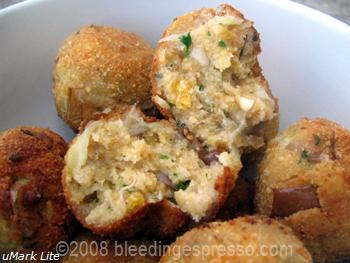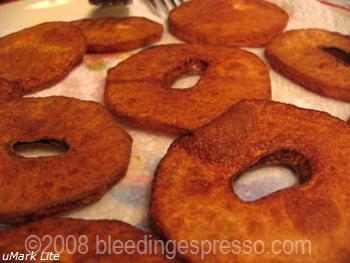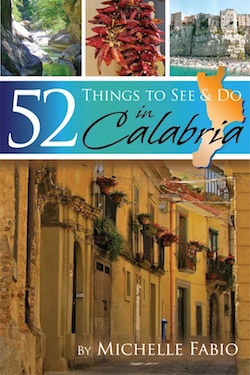Archive for the ‘what’s cooking wednesday’ Category
What’s Cooking Wednesday: Pasta with Calabrian Sausage
 I have to admit that I was not a fan of sausage before I moved here. Calabrian salsiccia is really something special though, and this simple dish has become one of my absolute favorites.
I have to admit that I was not a fan of sausage before I moved here. Calabrian salsiccia is really something special though, and this simple dish has become one of my absolute favorites.
If you’re going to make this week’s What’s Cooking Wednesday recipe, please try your hardest to get some Calabrian sausage. The main flavor you should be looking for inside la salsiccia is peperoncino — hot pepper. Look at the photo below–see how red the inside is? That’s not undercooked, that’s piccante. And YUM.
The recipe is super easy–just your basic tomato sauce really–so feel free to experiment, throw in some peppers, mushrooms, or whatever you like, although you probably won’t need extra peperoncino!
I know a lot of people take the sausage out of its casing and crumble it into the sauce, but the method described below really lets the sausage shine. Keeping the sausage in its casings would also allow for the traditional Italian meal of pasta for the first course and then meat for the second course–although we eat it all together anyway. My American influence on P perhaps?
Pasta with Calabrian Sausage
(serves 2)
- Pasta of your choice [recommended: fusilli or penne(short) or bucatini (long)]
- 2 tablespoons olive oil
- 1 small red onion, chopped finely
- 1 clove garlic, cut in half
- 2-4 Calabrian sausage links, depending on their size and how many people are eating
- Small handful of parsley, chopped
- Splash of red wine (optional)
- 1 can of tomatoes
- salt to taste
1. Heat about half a tablespoon of olive oil over medium heat in saucepan.
2. Poke holes in the sausage with a fork, add sausage to the pan, and and cook until browned on the outside, about 10 minutes. The sausage should also spring back from your touch a bit. It doesn’t have to be cooked through completely at this point as it will continue to cook in the sauce later, but you do want it mostly cooked.
3. Add another half a tablespoon of olive oil if the pan is dry; it may or may not be depending on the fat content in the sausage. Add onions, garlic, and parsley and sauté without letting them burn; you may have to turn down the heat a bit here.
4. Optional: Add wine and let cook off.
5. Turn the heat down to low and add tomatoes (put through a grinder or chopped to your liking), about a 1/4 cup of water to clean out the can, and salt to your taste. If sauce is still too thick, add some water; we often add up to 1/3 cup depending on the tomatoes. Cover and let simmer for another 10-15 minutes or until the tomatoes are done to your satisfaction (including proper thickness of sauce). If the sauce is too thin, let it cook for a bit without the lid on.
6. Prepare pasta and toss well with sauce. You could add some grated cheese, but I think this is delicious without.
Buon appetito!
What’s Cooking Wednesday: Potatoes, Peppers, & Eggs
 My grandmother used to make this week’s What’s Cooking Wednesday recipe, Potatoes, Peppers, & Eggs, any time of day and so do I.
My grandmother used to make this week’s What’s Cooking Wednesday recipe, Potatoes, Peppers, & Eggs, any time of day and so do I.
I tend to turn to this tried and true dish whenever I have peppers around that won’t get used otherwise or when I simply don’t know what else to eat but want something that’ll fill me up and keep me full.
And every time I make it, I wonder why I don’t make it more often because I really do love it. Pass the fresh bread! Yum!
I do this in a fancy scrambled eggs style, but you could just as easily turn this into a frittata/omelet. For me, scrambling the eggs is simply less labor-intensive, thus keeping the fast, easy, and delicious theme that we like so much around here.
Oh, you don’t want the potatoes in? Check out the Seven Fishes Blog‘s recipe for Peppers & Eggs here. And of course this would be great with ham, pancetta, onions . . . use your imagination, and whatever you have around that needs to be used up!
Potatoes, peppers, & eggs
(serves 2)
- 2 tablespoons olive oil
- 3 medium potatoes, peeled and cut into bite-sized chunks
- 1 large green pepper (or red, yellow, whatever you prefer), cut into strips
- 3 eggs
- 1 tablespoon grated cheese
- 1/2 teaspoon salt
1. Heat oil on medium in a pan that will be big enough to hold all ingredients.
2. Add peppers and toss so they are covered with oil. Lower heat and let cook for about 10 minutes or until tender.
3. Add potatoes, tossing well with oil and peppers. Cook for another 10 minutes or until potatoes are tender and light golden brown.
4. Meanwhile in a medium bowl, beat together eggs, cheese, and salt.
5. Pour egg mixture over potatoes and peppers, stirring frequently. Cook until eggs are no longer runny.
6. Grab some fresh bread and dig in!
Buon appetito!
What’s Cooking Wednesday: Calabrian Zeppole for St Joseph’s Day
 Happy St. Joseph’s Day! And to my dad, Happy Italian Father’s Day!
Happy St. Joseph’s Day! And to my dad, Happy Italian Father’s Day!
Perhaps you’re confused. That’s OK. You can read all about the Festa di San Giuseppe in last year’s post: Fava Beans and Cream Puffs. There you’ll also find a photo of my great-great-grandfather a.k.a. the reason I ended up in my charming village.
Auguri Papù and to all Josephs, Giuseppes, and dads out there!
Also to Giuseppinas, Josephines, and any others celebrating!
Also, if some of you happen to remember St. Joseph’s Day altars from childhood but are missing them right about now, check out this Virtual St. Joseph’s Day Altar. If you don’t have any idea what I’m talking about, read about this tradition.
Now . . . it’s time for zeppole.
Or as we say around here, zippoli.
As I noted in last year’s post, this word means many different things depending on where in Italy you are. This is a common phenomenon, and in fact, just last night I read a similar sentiment in Laura Schenone’s The Lost Ravioli Recipes of Hoboken: A Search for Food and Family:
“Prescinsêua cheese may mean one thing in the city, but to some contadini in the country it may mean something completely different.”
So, in that vein, some of you know zeppole as cream puffs, but there ain’t no cream in the Calabrian version. In fact, there are anchovies.
How’s that for una sorpresa if you’re expecting cream?
I have a very vague memory of my grandmother [perhaps] making these with anchovies when I was small, but the ones I remember best were simply coated in sugar while they were still hot.
Ah . . . zeppole memories . . .
Waiting patiently at my grandmother’s hip (seriously I was that high, or low I should say as she was under 5 feet tall) for these to cool down ever so slightly to dig in. She never got even near a platter-full before one batch was already gone. They’re that good.
Unfortunately for my recipe repertoire though, my grandmother didn’t make her own dough in her later years when kneading wasn’t possible; she always bought fresh dough from the *best* local pizzeria and bakery.
Indeed, she’d pick up the dough early Friday morning (during Lent especially), make pizzas throughout the day and then fry these babies up just as we were finishing up on the pizza. I cannot tell you how much I miss walking into that house on Friday afternoons after school.
MAMMA MIA . . . CHE PROFUMO!
So I went to a few sources for a recipe:
(1) P’s mom; (2) my friend Alida from nearby Isca sull’Ionio who I met in Philadelphia (she brought homemade biscotti to our first in-person meeting!); and (3) my dear friend Mary Amabile Palmer’s cookbook Cucina di Calabria: Treasured Recipes and Family Traditions from Southern Italy.
Between these wonderful women (grazie mille!), I am tasting exactly what I remember swiping off paper towels as a child. And now you can enjoy them too.
Zeppole con Alici o Semplice
(I Zippoli Calabrese)
Fried Dough with Anchovies or Plain
- 1 package active dry yeast or 10 g of fresh yeast
- 1 1/4 cups warm water
- 3 cups all-purpose or “00” flour
- 1/2 teaspoon salt
- Splash of white wine
- 1 small jar or can of anchovies
- vegetable oil for frying
- confectioner’s or regular sugar for dusting (if making plain version)
1. Dissolve yeast in 1/4 cup of warm water.
2. Put salt and flour in a mound on your working space, a wooden board if possible, although I use something like this like my grandmother used.
3. Make a well in the center and gradually add the dissolved yeast, remaining water, and wine pulling flour into the liquid as you go.
4. Knead for between 5 and 10 minutes until the dough is smooth, elastic, and “bella morbida” as my suocera kept saying–quite soft. If you’re used to making pizza, you may have recognized these ingredients; just make sure the dough here is softer than for pizza.
5. Put dough ball in oiled bowl, cover it with a towel, and put in a dry, warm place to rise for about 2 hours.
6. After the dough has doubled in size, take it out, and knead it for another few minutes. Then put it back in the bowl and allow it to rise again for another couple hours. This will make for fluffier zeppole, but if you don’t have time, just let it rise once. They’ll still be good.
7. In the meantime, if you’re using anchovies, prepare them by removing them from their container and draining oil. Cut them in two pieces so that they will fit into a pocket of dough that will end up being about the size of the palm of your hand once folded over.
8. Heat oil over medium heat.
9. Pull off small chunks of dough about golf-ball size, flatten, and stretch into a rectangle. Place anchovy or two inside and fold over, sealing edges well. If you’re making the plain version, simply stretch to dough to the size of the palm of your hand.
10. Fry in hot oil for 3 to 4 minutes, turning zeppole so they are lightly brown all sides.
11. Remove from oil with slotted spoon and place on paper towels to drain.
12. If you are making them without anchovies, dust them with sugar while they’re still hot–and if you’re like me and actually like the anchovy-filled ones with sugar as well (ssh–they think I’m very weird here for this), go right ahead!
Note you can also fill these with lots of other things. Raisins, for example, are delicious inside and then I recommend dusting with confectioner’s sugar.
Buon appetito!
What’s Cooking Wednesday: Eggplant Balls
Think of these as . . . meatballs without the meat. Vegetarian meatballs? Aubergine croquettes? Balls o’ eggplant? Polpette di melanzane?
Whatever you choose to call them, I call them fabulous and this week’s What’s Cooking Wednesday recipe.
Yesterday was market day, which, ever since I got back from Sicily and a fabulous plate of Pasta alla Norma, has meant a handful of eggplants coming home with me.
I love eggplant balls without any kind of sauce, but you could certainly use a basic tomato sauce as a dip (such as this dipping sauce for fried mozzarella) or even something creamy like perhaps you’d use (although I don’t) for fried zucchini.
Also if you want to make them a little fancier, shape them wider and flatter instead of in balls. Either way these are *delicious* and also a great way to hide eggplant in something tasty.
Eggplant balls
(Polpette di melanzane)
[makes about 18 balls]
- 1 medium eggplant
- 1 1/4 cup breadcrumbs (put aside 1/4 cup for rolling before frying)
- 2 cloves garlic, minced
- 1/4 cup grated Parmigiano Reggiano/Grana Padano cheese
- 2 tablespoons fresh basil and/or parsley, chopped
- 1 egg
- salt to taste
- olive oil for frying
1. Put pot of water on high heat. When water reaches a boil, turn down the heat a bit, cut eggplants in half (and then in half again if you’re using the smaller, fatter eggplants like I do), leaving the skins on, sprinkle a good bit of salt into the water, and then add the eggplant. Let simmer for about 20 minutes or until they are tender.
2. Remove eggplant, drain, and pat dry, letting them cool before chopping them into small cubes, about 1/4 inch in size.
3. Put eggplant in large mixing bowl and add bread crumbs, garlic, cheese, parsley, basil, egg, and salt and mix well. If the mixture is too moist, add more bread crumbs.
4. Shape into balls and then roll balls in breadcrumbs.
5. Heat about 2 tablespoons of olive oil in a large frying pan over medium/high heat. When oil is hot, add eggplant balls one at a time without crowding them. Turn them often with a wooden spoon to make sure all sides get brown, which should take anywhere from 3-6 minutes.
Buon appetito!
what’s cooking wednesday: calabrian prickly zucchini
 I hope you don’t mind, but we’re taking a break from Sicily to come back to Calabria for a moment.
I hope you don’t mind, but we’re taking a break from Sicily to come back to Calabria for a moment.
Today’s What’s Cooking Wednesday recipe probably isn’t one you’re going to rush out and try, but I couldn’t let another week go by without writing about:
Prickly zucchini
Actually I didn’t even know that would be an acceptable name in English for them, but it was my guess, so that’s what I typed into Google, and found a post by Rowena at Rubber Slippers in Italy (Great blog! Go read it!) entitled: Prickly Zucchini from Calabria.
Bingo!
I asked around a bit here, and no one even knows the name of these spiny little things in Italian; in Calabrese they are “cucuzze spinusi” where cucuzze is a general name for zucchini/pumpkins and spinosi (spinusi in Calabrese) means spiny or prickly.
And because of Rowena’s commenters, I learned that our cucuzze spinusi are better-known as chayote, popular in many parts of the world, particularly Mexico. Also, Wikipedia tells me that the Italian name is zucca centeneria, but I’ll stick with cucuzze spinusi since no one around these parts would know what I’m talking about otherwise.
That same Wikipedia page gives some serving suggestions, which are basically all the things you’d do with un-prickly zucchini (yes, I was tempted to write “prickless”), but I’m going to share the way everyone eats them here–this according to a very informal survey at the local grocery store.
Fried Prickly Zucchini
Prickly zucchini
Flour
Salt
Olive oil for frying
So you’re probably wondering how to get the spines off.
First, these are real spines, not like the baby ones that prickly pears have. So first trim off the spines with a sharp knife and then peel it “come la mela” (like an apple) as P says.
Slice the zucchini to your desired thickness, discarding the innards along the way.
Mix a bit of salt with flour in a shallow bowl, and get dredging.
Fry them up until they’re a light golden brown (P left the ones in the photo in the oil *a tad* too long but they were still delicious), and you can taste your very first fried prickly zucchini.
Buon appetito!

